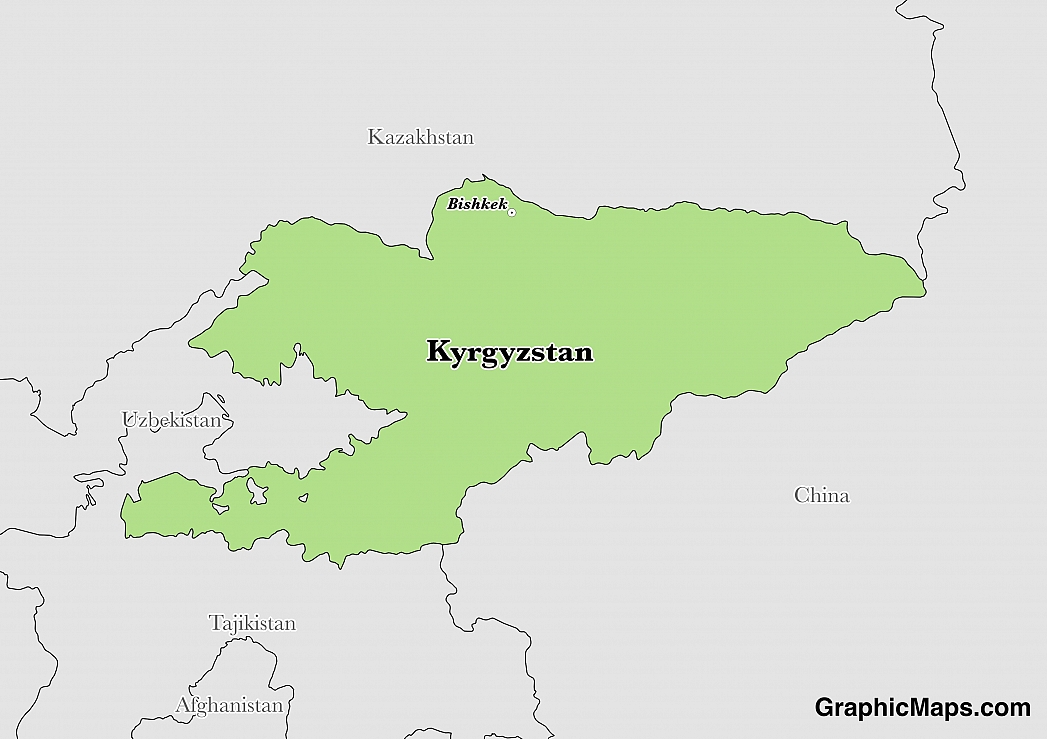Where is Kyrgyzstan?
Located in Central Asia, Kyrgyzstan has a 4,573.00 km border with China (1,063 km), Kazakhstan (1,212 km), Tajikistan (984 km) and Uzbekistan (1,314 km). Kyrgzstan has yet to ratify the 2001 boundary delimitation with Kazakhstan.
The capital city of Kyrgyzstan is Bishkek. It is also the largest city in the country, as well as its cultural and economic hub. The city is well-connected by major roads and rail lines. Bishkek experiences a hot and dry continental climate with the temperatures with a range of 3 degrees Celsius in January to 31 degrees Celsius in July. During summer, dryness is witnessed accompanied by thunderstorms. In winter, snow storms and thick fog is common.
Read more on Kyrgyzstan's CapitalKyrgyzstan is an Asian country covering 199,951.00 km2 of which 4.08% is water and 191,801.00 km2 is land. This makes it the 85th largest country in the world and slightly smaller than South Dakota. Its geographic coordinates are 41 00 N, 75 00 E and Bishkek is the capital city.
Its name comes from a combination of the Turkic words "kyrg" and "yz".
Its ISO code is KG.
Geography
Kyrgyzstan has a mean elevation of 2,988 m above sea level.
It has a continental climate that is dry in mountainous regions, subtropical in the southwest, and temperate in the foothills. Its terrain is composed of mountains, valleys, and basins.
Population
Kyrgyzstan has a population of 5,727,553 making it the 114th largest in the world. The majority of the country lives in rural areas.
Kyrgyz is the official language; Uzbek and Russian widely spoken. The major ethnic group is Kyrgyz followed by Uzbek. The most common religion group is Muslims, with a significant Russian Orthodox minority.
In Kyrgyzstan, there are many languages spoken. However, it is estimated that Kyrgyz is spoken around 70% of the country's population, making it the majority language. There are other several sub-languages within the region. The original composition of the Kyrgyz language was in Turkic tunes, but years later the tunes were replaced by Perso-Arabic alphabet. It is stated that Kyrgyzstan is a bilingual country in which the country uses both the Kyrgyz and the Russian language.
Read more on Kyrgyzstan's LanguagesThe dialing code for the country is 996.
Government
Kyrgyzstan is an independent country. It gained independence with the dissolution of the Soviet Union in 1991. Its constitution was last ratified in 2010.
?Kyrgyzstan is an independent republic nation. The president heads the head of the country which is composed of three arms. While the prime minister is the head of the government of Kyrgyzstan, the government itself is composed of representatives of the citizens of ?Kyrgyzstan who are the members of the national assembly. Elections in ?Kyrgyzstan are conducted by the electoral commission of Kyrgyzstan.
Read more on Kyrgyzstan's GovernmentEconomy
Factoring in Purchasing Power Parity, Kyrgyzstan's GDP is $21,010,000,000.00 (USD) with $3,500.00 (USD) per capita. This makes it the 143rd largest economy and its citizens the 175th richest in the world. The currency of Kyrgyzstan is the Som (KGS).
Its major export partners are Switzerland, Uzbekistan, and Kazakhstan. Its main exports are gold, cotton, wool, and garments. Its major import partners are China, Russia, and Kazakhstan. Its major imports include oil and gas, machinery, chemicals, and foodstuffs.
Flag
The flag of ?Kyrgyzstan is the national symbol of the state. The national flag that is flown today was adopted in 1992. Previously, the area that is today known as Kyrgyzstan flew the Flag of the Kirghiz Soviet Socialist Republic, which had five strips of white, blue, and red. Some variations of the flag also featured a hammer and sickle.
Read more on Kyrgyzstan's FlagThis page was last modified on January 17th, 2018
More on Graphicmaps

Published on 2019-11-06
What is a Trade Embargo?

Published on 2019-11-04
Which Two Countries Used to Have the Same Flag?

Published on 2019-09-16
What Is the Only Two-Sided State Flag?

Published on 2019-09-16
Which Country Flag Looks Like the Texas Flag?

Published on 2019-08-29
Flags That Resemble the US Flag

Published on 2019-08-20
